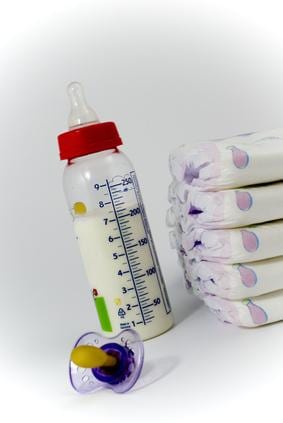In the United States, baby formula is highly regulated. Strict standards must be upheld by formula manufacturers that touches on everything from where the formula is made to what it contains. That means that Gerber Good Start and Wal-Mart’s Parent’s Choice baby formulas are both measured by the same yard stick. The big difference is in price–Parent’s Choice runs about $10 less per can than Good Start. Both brands have a multitude of formulations.
Iron
Breast milk doesn’t contain high levels of iron, but what it does contain is easily absorbed by your baby. Formula makers have struggled to create an easily absorbed iron but haven’t had a lot of success; you’ll find that baby formula has high quantities of added iron. It’s difficult to find a baby formula that isn’t fortified with iron. Check the label to be sure.
DHA and ARA
DHA, or docosahexaenoic acid, helps in brain and eye development. It contains high levels of omega-3 fatty acids, much like what adults obtain from eggs and fish. ARA, or arachidonic acid, is an omega-6 fatty acid that works with DHA to promote healthy immune systems. Adults acquire it in nuts and seeds.
Proteins
Most formulas mimic breast milk in that they contain whey as their main source of protein. Soy formula’s primary protein is soy. When the label reads “partially hydrolyzed,” it means the proteins have been broken down for easier digestion. It is also thought that partially hydrolyzed soy formula can sometimes help relieve atopic dermatitis. Highly hydrolyzed formulas break down proteins even further and are made especially for babies with protein allergies.
Carbohydrates
In cow’s milk-based formulas, lactose is the key carbohydrate just as it is in breast milk. Alternative formula blends, like soy, lactose-free and hypo-allergenic formulas, often contain corn maltodextrin, sucrose, corn syrup solids or modified cornstarch as their primary source of carbs.
Additional Ingredients
Sometimes, formula contains extra ingredients to treat special symptoms like diarrhea or acid reflux. Rice starch is often added to formulas to help soothe the bellies of babies who spit up or vomit frequently due to acid reflux. Nucleotides can be added to increase immune system development. Sometimes amino acids are added to the mix to try and match the level of amino acids found naturally in breast milk.
Considerations
Supplementing a breastfed baby’s diet with formula is a good way to get extra iron in her diet. It’s also convenient for mom and dad. Even if a breastfed baby is content to drink breast milk from a bottle, she may reject a bottle of formula. Consider planning a formula taste test–for yourself. By sampling several different varieties, you’ll be able to determine which formulas have unusual textures, flavors or aftertastes that might be putting your baby off.
Photo Credit
- baby set image by Daniel Fuhr from Fotolia.com





